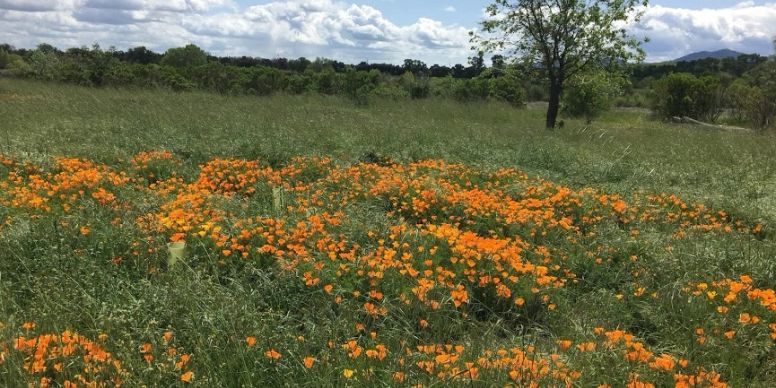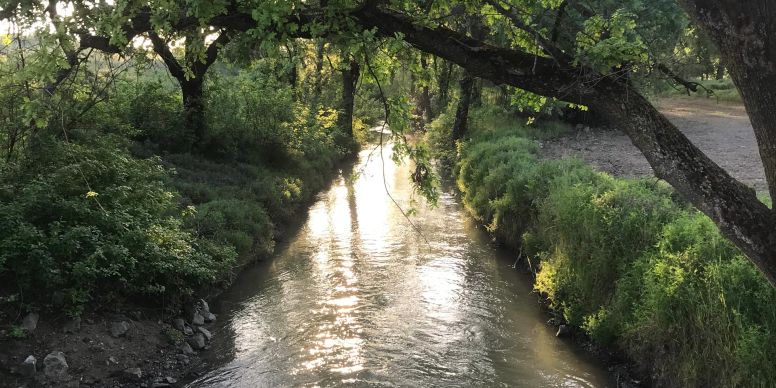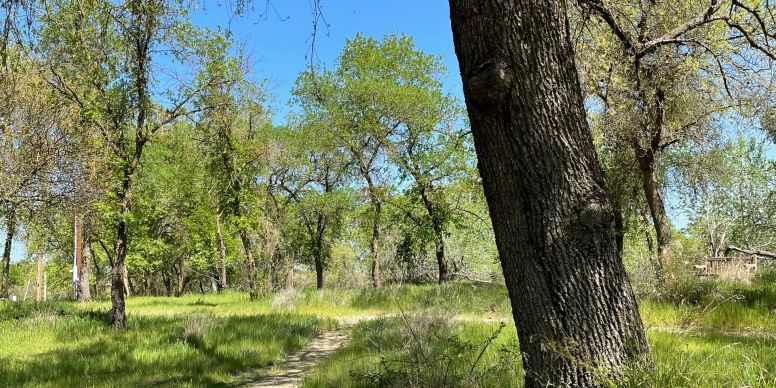Habitat Restoration
Restoration projects along Lower Cache Creek and within the Nature Preserve are the main focus of the the Cache Creek Conservancy.



The simple definition of habitat is the natural home or environment of an animal, plant, or other organism. Habitats can be grouped into kinds of habitats that have similar characteristics. For the Conservancy, the habitats on the Nature Preserve are
- native grasslands
- oak savannah
- riparian forest
- wetlands
- the “farm area” (where the buildings are)
- and the Tending and Gathering Garden
Restoration is the action of returning something to a former condition. For the Conservancy, restoration includes taking the following actions on the landscape.
- Revitalization, like removing invasive plants and planting natives
- Reshaping or rebuilding the terrain to provide better habitat
- Land management like burning and grazing projects
- Monitoring and analysis to help scientists adapt management practices
- Educating the public about the importance of healthy environments and how to grow them
The Conservancy recently completed four major habitat improvement projects at the Preserve; a riparian restoration project, reshaping of the wetland islands and two major burns.
Cache Creek Riparian Enhancement Project
You wouldn’t know it to look at it today, but in 2015, the riparian trail at the Preserve was overshadowed with Himalayan Blackberries and non-native fig trees. Even though the deer and other wildlife would eat the fruit of those plants, it was not a good diet for them because their systems are not adapted to it.
The Conservancy received a $285,470 Environmental Enhancement and Mitigation Program Grant from the California Natural Resources Agency in 2015. This grant was to remove the blackberry bushes, fig trees, and other other invasive species as well as to plant native plants in their place.
The improvement was immediately noticeable once the blackberry and fig were removed. Sunlight now filters through the cottonwood and other riparian trees and native grasses and plants are thriving. Community members and Conservancy interns planted more than 2,000 plants and plugs of grasses in the now cleared areas. With these improvements we are noticing more and varied wildlife, especially with birds, including nesting pairs of ospreys and Swainson’s hawks.
Originally this project was to be done in three years, but winters in 2017 and 2019 saw so much rain that the project area was flooded and work was delayed.
Although a lot of tremendous work has been done, there is always still more to do. The Conservancy continues to work on improving the habitat and trails in the riparian area.
Cache Creek Wetlands and Associated Riparian and Upland Habitats Project
The Conservancy received a $94,892 grant from NAWCA (North American Wetlands Conservation Act) to
- enhance 29.7 acres of wetland vegetation habitat
- enhance 91 acres of wetland-associated upland and riparian habitat
- establish 1.3 acres of palustrine (P), forested (FO) (PFO) habitat
Get map wetland-dependent species like Tri-colored blackbirds, Giant Garter Snakes, and Western Pond Turtles.
Phase I of this project involved reshaping some of the wetland islands, planting wetland vegetation (tule and cattails) and palustrine (always flooded) forest wetland habitat (willows and native grasses).
By reshaping habitat islands, establishing flooded palustrine forest wetland (PFO) habitat, and managing for native vegetation for better nesting and foraging opportunities, the Conservancy hopes to see population increases in wetland-dependent species including Giant Garter Snake, Western pond turtle, and wood ducks.
Other environmental benefits of this project include increasing resilience against non-native, invasive plants by establishing native vegetation and physically removing niches that invasive, non-native species have occupied. Target wildlife species will have more habitat for foraging and nesting and the public will have better recreational and educational opportunities at the CCNP.
The history of aggregate mining along lower Cache Creek has had significant negative impacts to the biodiversity and ecology of the watershed. Since 1975, changes in California mining laws and the 1996 Yolo County Cache Creek Area Plan have reduced those impacts. Successful wetland and riparian restoration projects, such as the ongoing restoration of the CCNP wetlands, offers us hope as well as pathways towards a future of enhanced ecological integrity, biodiversity, beauty, and recreational opportunities.
Fire Projects
Fire is an important land management tool. There are two types of fire: prescribed burns and cultural burns. California native plants are adapted to fire and it helps the plants stay healthy and reproduce (i.e, the California redwood needs fires for the seeds to germinate). Both types of burns provide benefits to the environment by burning away invasive species or disease, adding nutrients to the soil, and promoting new growth.
The main objective of the burn is basic distinction between the two. Prescribed burns are used to reduce dried plant material that can be fuel in wildfires (called fuel load). Cultural burns are used to promote plant health and produce the plant materials important to Native American cultural practices (e.g., basket weaving, food, or medicine, etc.).
Recently the Conservancy partnered with CalFIRE to conduct both types of burns. In both instances, the burns were training exercises for Conservancy staff, students from UC Davis’ Keepers of the Flame class, and CalFIRE employees.
April 28, 2022, was a prescribed burn in the wetland. Years of dried tules created a matted layer of debris that did not offer benefits to plants, animals, or birds. Burning the tule cleared the land and the Conservancy can now focus on new plantings and establishing wetland-dependent species habitat in the area. See video of the prescribed burn here. [link, will need to upload on YouTube)
March 8, 2022, a cultural burn was conducted in partnership with the Keepers of the Flame class at UC Davis. In what is becoming an annual event, students from the class spent several sessions preparing parts of the TGG for the burn. For example, redbud is cut down close to the ground (called coppicing) and the branches are stacked on top for the burn. Redbud is an important plant in Native American basketry, and burning it produces new growth that is straighter and more flexible for the weavers to use. See CalFIRE photos and video of the cultural burn on the CalFIRE flickr page.
Other Related Resources
Cache Creek Resource Management Plan (PDF)
Cache Creek Nature Preserve Tending and Gathering Garden
Keepers of the Flame (PDF from UCD class)
